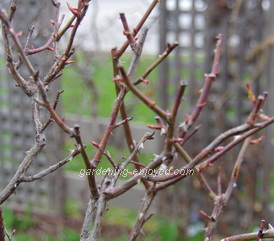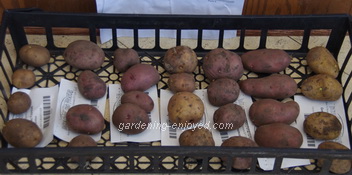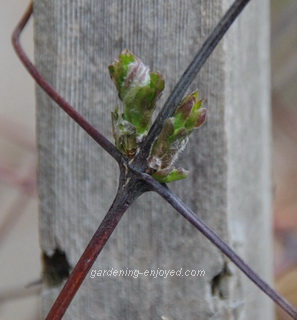| Back to Back Issues Page |
 |
|
Dallying In The Dirt, Issue #168 --- Chitting Potatoes is a technique to hurry the summer's crop May 02, 2014 |

The Asparagus is up! The Asparagus is up! Well, a couple of small tips have emerged through the mulch and on the first of May. It might be several more days before there is enough heat to actually make it grow large enough to pick and at this point I can only find two little stalks coming from the highest and driest part of the garden. Having made that wonderful discovery, I started to wander around the garden and see what the winter had done to various things. I know there is a complicated and scientific answer but I’m still fascinated that the Explorer Rose that I made into a little tree is quite alive and all of its buds are emerging, well above, where the snow line may have protected them. Immediately beside it is a heavily caned regular Rose and all of its canes are black and
lifeless right down to the soil line. It may emerge from the soil or it may not. How can these two very similar plants have such dissimilar physiology?  The doorbell rang yesterday afternoon while I was busy tiling the bathroom wall. It was way to wet to go outside anyway, so the bathroom reno was not cutting into gardening time. The nice lady at the door handed me a small white paper bag and pointed out that my neighbour around the corner had just received his as well. The seed Potatoes had arrived. The urge to rush out and plant them was dampened by the unfinished tiling job and the small lake in the back yard where these Potatoes will eventually find their home. All is not lost. All anxious Potato growers will do some chitting. That’s a British term that means starting the eyes on the tubers to develop into strong growing shoots. Some will start them a few weeks early but I’m not that organized and my supplier Eagle Creek Potatoes will not ship them any earlier because they would freeze in transit. We all know what
a “do not freeze” label does on a postage parcel. Potatoes usually have most of their eyes on one end and the Potato should be placed in a cool, brightly lit space with that end up. Some people use egg cartons to hold them in position. Because mine are only going to be chitted for a week or so until I can get them in the garden, I just lay them in a flat and put them on the floor of the solarium. Seems to work just fine.
The doorbell rang yesterday afternoon while I was busy tiling the bathroom wall. It was way to wet to go outside anyway, so the bathroom reno was not cutting into gardening time. The nice lady at the door handed me a small white paper bag and pointed out that my neighbour around the corner had just received his as well. The seed Potatoes had arrived. The urge to rush out and plant them was dampened by the unfinished tiling job and the small lake in the back yard where these Potatoes will eventually find their home. All is not lost. All anxious Potato growers will do some chitting. That’s a British term that means starting the eyes on the tubers to develop into strong growing shoots. Some will start them a few weeks early but I’m not that organized and my supplier Eagle Creek Potatoes will not ship them any earlier because they would freeze in transit. We all know what
a “do not freeze” label does on a postage parcel. Potatoes usually have most of their eyes on one end and the Potato should be placed in a cool, brightly lit space with that end up. Some people use egg cartons to hold them in position. Because mine are only going to be chitted for a week or so until I can get them in the garden, I just lay them in a flat and put them on the floor of the solarium. Seems to work just fine.Now it’s time to answer a few of my reader’s questions. Don’t forget to check the front page of the Website for frequent short ideas for current gardening activities. Nancy Asks? Can I plant snow peas with the hardware cloth technique or the chain link fence technique? 111 Trent St. W. |
| Back to Back Issues Page |
 I’m always amazed that
I’m always amazed that